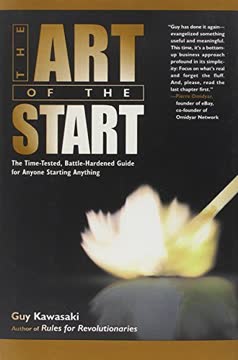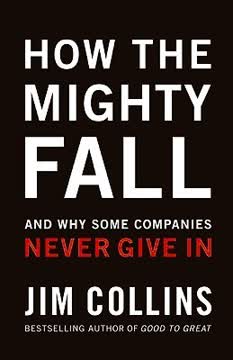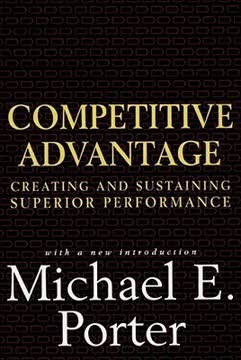Key Takeaways
1. Analyze industry structure using the five competitive forces
The state of competition in an industry depends on five basic competitive forces.
Industry structure determines profitability. The five forces - threat of new entrants, bargaining power of suppliers, bargaining power of buyers, threat of substitute products, and rivalry among existing firms - shape the competitive landscape. By analyzing these forces, companies can assess the industry's potential for profitability and identify opportunities to improve their position.
- Threat of new entrants: Depends on entry barriers like economies of scale, product differentiation, capital requirements, and government policy
- Bargaining power of suppliers: Influenced by supplier concentration, importance of volume to supplier, and differentiation of inputs
- Bargaining power of buyers: Affected by buyer concentration, buyer information, and price sensitivity
- Threat of substitutes: Determined by relative price performance of substitutes and switching costs
- Rivalry among existing firms: Intensified by industry growth rate, fixed costs, and exit barriers
Understanding these forces allows firms to develop strategies that exploit industry structure or work to reshape it in their favor.
2. Choose a generic competitive strategy: cost leadership, differentiation, or focus
Firms can sometimes pursue more than one approach as its primary target, though this is rarely possible.
Select a clear strategic direction. Companies must choose one of three generic strategies to achieve competitive advantage: cost leadership, differentiation, or focus. Each strategy requires a distinct set of organizational arrangements and resources.
- Cost leadership: Achieve lowest costs in the industry through economies of scale, proprietary technology, and preferential access to raw materials
- Differentiation: Offer unique products or services valued by customers, allowing premium pricing
- Focus: Target a specific market segment or product line, applying either a cost leadership or differentiation approach
Attempting to pursue multiple strategies simultaneously often results in a firm becoming "stuck in the middle" with no competitive advantage. However, in rare cases, a company may successfully implement more than one approach, typically through separate business units or exceptional circumstances.
3. Understand competitors through comprehensive analysis of their goals, assumptions, and capabilities
Sophisticated competitor analysis is needed to answer such questions as "Who should we pick a fight with in the industry, and with what sequence of moves?"
Create competitor profiles. A thorough competitor analysis involves examining four key components: future goals, current strategy, assumptions, and capabilities. This framework allows companies to predict competitors' likely moves and responses to industry changes.
- Future goals: Analyze financial targets, market share ambitions, and broader organizational objectives
- Current strategy: Assess how the competitor is currently competing in the market
- Assumptions: Identify competitors' beliefs about themselves and the industry
- Capabilities: Evaluate strengths and weaknesses in various functional areas
By synthesizing this information, firms can develop a competitor response profile, anticipating how rivals will react to strategic moves and industry changes. This understanding is crucial for formulating effective competitive strategies and identifying opportunities to outmaneuver competitors.
4. Recognize and interpret market signals to anticipate competitive moves
Market signals are indirect means of communicating in the marketplace, and most if not all of a competitor's behavior can carry information that can aid in competitor analysis and strategy formulation.
Decipher competitive intentions. Market signals are actions by competitors that provide indirect indications of their motives, goals, or internal situation. By recognizing and accurately interpreting these signals, companies can gain valuable insights into competitors' strategies and potential moves.
Types of market signals:
- Prior announcements of moves
- Public discussions of industry conditions
- Competitors' explanations of their own actions
- Divergence from past behavior or industry norms
- Cross-parry responses
Interpreting signals requires a deep understanding of the industry context and competitors' situations. It's crucial to distinguish between true signals and potential bluffs designed to mislead rivals. Effective signal interpretation can help firms anticipate competitive threats, identify opportunities, and make more informed strategic decisions.
5. Develop strategies for different industry environments: fragmented, emerging, mature, and declining
Industry evolution is important strategically because evolution, of course, brings with it changes in the structural sources of competition.
Adapt to industry lifecycles. Different industry environments require distinct strategic approaches. Companies must recognize the characteristics of their industry's stage and adjust their strategies accordingly.
Strategies for various industry environments:
- Fragmented industries: Pursue consolidation, increase value-added services, or focus on a specific market segment
- Emerging industries: Shape industry structure, influence standards, and build strong market positions
- Mature industries: Emphasize cost efficiency, product innovation, and market segmentation
- Declining industries: Consider harvesting, niche strategies, or market leadership
Each stage presents unique challenges and opportunities. In fragmented industries, firms may seek economies of scale or scope. Emerging industries often require significant investments in R&D and marketing to establish market presence. Mature industries typically involve intense competition, necessitating cost control and differentiation. Declining industries may require difficult decisions about divestment or repositioning.
6. Make informed decisions about vertical integration and capacity expansion
The essence of the vertical integration decision is not the financial calculation itself but rather the numbers that serve as the raw material for the calculation.
Evaluate strategic implications. Vertical integration and capacity expansion decisions have far-reaching consequences for a firm's competitive position. These decisions must be based on a thorough analysis of strategic benefits and costs, not just financial calculations.
Factors to consider in vertical integration:
- Economies of integration
- Technological interdependence
- Assured supply or demand
- Offset bargaining power of suppliers or buyers
- Enhanced ability to differentiate
Capacity expansion considerations:
- Timing relative to industry growth
- Impact on industry supply-demand balance
- Potential for preemption or deterrence of competitors' expansions
Both vertical integration and capacity expansion can significantly alter industry structure and competitive dynamics. Firms must carefully weigh the potential benefits against the risks and costs, considering long-term strategic implications rather than short-term financial gains.
7. Evaluate opportunities for entry into new businesses
The choice of which emerging industry to enter is dependent on the outcome of a predictive exercise such as the one described above.
Assess entry attractiveness. Entering new businesses can be a powerful strategy for growth and diversification, but it requires careful analysis of industry attractiveness and the firm's ability to compete successfully.
Key considerations for evaluating entry opportunities:
- Industry structural attractiveness (using five forces analysis)
- Entry barriers and expected retaliation from incumbents
- Firm's resources and capabilities relative to entry requirements
- Potential for creating competitive advantage in the new industry
- Synergies with existing businesses
Entry strategies may include internal development, acquisition, or joint ventures. The choice depends on the urgency of entry, the firm's capabilities, and the nature of the target industry. Successful entry often requires a clear understanding of the industry's key success factors and the ability to bring unique strengths or resources that can create a sustainable competitive advantage.
Last updated:
FAQ
What's Competitive Strategy by Michael E. Porter about?
- Focus on Competitive Forces: The book analyzes the competitive forces that shape industries and influence a firm's strategy, introducing the "five forces" framework.
- Framework for Analysis: Porter provides a systematic approach to understanding industry structure and dynamics, helping managers identify competitive pressures.
- Strategic Decision-Making: Emphasizes the importance of strategic decision-making in achieving a competitive advantage, guiding firms on effective positioning.
Why should I read Competitive Strategy by Michael E. Porter?
- Influential Framework: The book is a foundational text in business strategy, widely used in academic and professional settings.
- Practical Tools: Offers practical tools and techniques for analyzing industries and competitors, valuable for strategic planning or management.
- Timeless Concepts: Despite being published in 1980, the concepts remain relevant, addressing fundamental principles of competition.
What are the key takeaways of Competitive Strategy by Michael E. Porter?
- Five Forces Framework: Understanding the five competitive forces is crucial for analyzing industry structure and profitability.
- Generic Competitive Strategies: Porter outlines three strategies—cost leadership, differentiation, and focus—that firms can adopt for competitive advantage.
- Importance of Competitor Analysis: A thorough competitor analysis is essential for predicting rivals' actions and formulating effective strategies.
What is the Five Forces framework in Competitive Strategy by Michael E. Porter?
- Entry Barriers: Identifies barriers to entry as a critical factor influencing competition, protecting established firms from new entrants.
- Buyer and Supplier Power: Examines how the bargaining power of buyers and suppliers affects pricing and profitability.
- Threat of Substitutes: Discusses how substitute products limit pricing power, requiring firms to compete on price or differentiate offerings.
How does Competitive Strategy by Michael E. Porter define generic competitive strategies?
- Cost Leadership: Involves becoming the lowest-cost producer, focusing on efficiency and cost control to offer competitive pricing.
- Differentiation: Entails creating unique products or services that stand out, investing in branding and quality to justify premium pricing.
- Focus: Targets a specific market segment, achieving either cost advantage or differentiation within that niche.
What are the best quotes from Competitive Strategy by Michael E. Porter and what do they mean?
- "The essence of formulating competitive strategy is relating a company to its environment.": Highlights the need for deep analysis of industry dynamics and competitive forces.
- "A firm that is 'stuck in the middle' is in an extremely poor strategic situation.": Warns against not committing to a clear competitive strategy.
- "The collective strength of these forces determines the ultimate profit potential in the industry.": Emphasizes the significance of the five forces in shaping industry profitability.
How can firms use Competitive Strategy by Michael E. Porter to improve their market position?
- Identify Competitive Advantage: Use the frameworks to identify and leverage unique strengths in the market.
- Adapt to Market Changes: Remain flexible and responsive to changes in the competitive landscape.
- Focus on Core Competencies: Concentrate on core competencies to enhance operational efficiency and strengthen positioning.
What role does strategic analysis play in Competitive Strategy by Michael E. Porter?
- Framework for Decision-Making: Provides a structured approach for evaluating the competitive environment and making informed decisions.
- Resource Allocation: Guides firms in allocating resources effectively, ensuring investments yield high returns.
- Long-Term Planning: Essential for anticipating market changes and adapting strategies accordingly.
How does Competitive Strategy by Michael E. Porter address declining industries?
- End-Game Strategies: Discusses strategies like harvesting cash flow, divesting, or repositioning to manage resources effectively.
- Understanding Competition: Highlights the complexity of competition in declining industries, requiring unique analysis.
- Exit Barriers: Emphasizes understanding exit barriers that can prevent firms from leaving a declining market.
What are the strategic implications of industry maturity in Competitive Strategy by Michael E. Porter?
- Increased Competition: Maturity leads to intensified competition, requiring firms to adapt strategies to maintain market share.
- Focus on Cost and Efficiency: Emphasizes cost control and operational efficiency in mature industries.
- Need for Innovation: Encourages innovation and differentiation to attract customers and sustain growth.
How does Competitive Strategy by Michael E. Porter suggest firms should approach market signals?
- Recognizing Signals: Firms should be attuned to market signals indicating competitors' intentions or strategies.
- Interpreting Signals: Analyze the context and history of competitors' actions to interpret signals accurately.
- Using Signals Strategically: Use market signals to inform strategic moves and position advantageously.
What are the risks associated with the generic strategies outlined in Competitive Strategy by Michael E. Porter?
- Cost Leadership Risks: Includes technological changes that can nullify cost advantages and the need for continuous efficiency investment.
- Differentiation Risks: Competitors may imitate unique features, and high costs can erode brand loyalty.
- Focus Risks: Vulnerability to changes in buyer preferences and exploitation of submarkets by competitors.
Review Summary
Competitive Strategy is highly regarded as a seminal work on business strategy, offering frameworks like Porter's Five Forces for analyzing industries and competition. Readers praise its comprehensive approach and timeless principles, though some find it dense and dated in examples. The book is considered essential reading for business leaders and students, providing valuable insights into competitive analysis, market positioning, and strategic decision-making. While challenging to read, many find its concepts applicable and relevant decades after publication.
Similar Books








Download PDF
Download EPUB
.epub digital book format is ideal for reading ebooks on phones, tablets, and e-readers.







